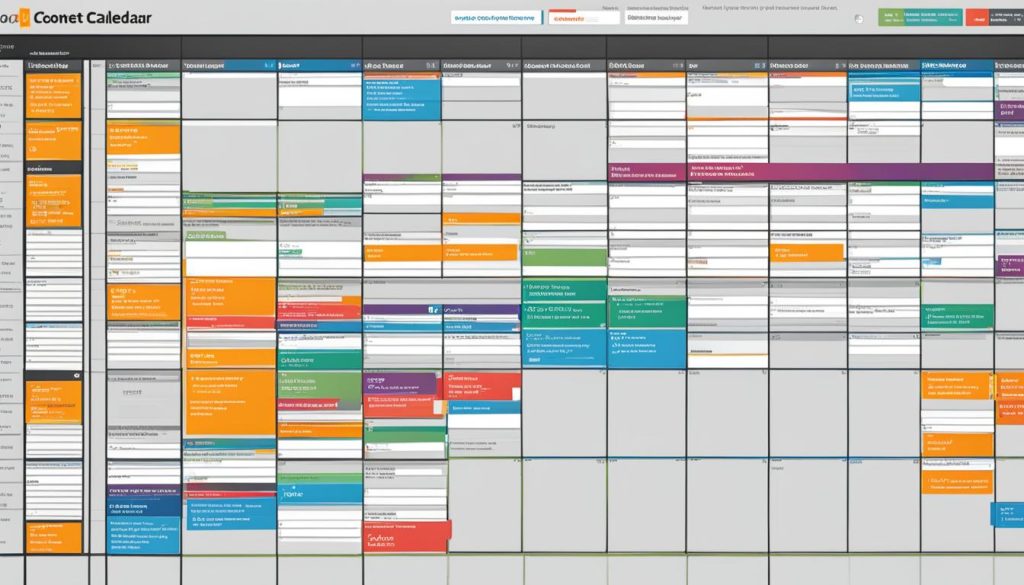Maximize Planning with 18 Benefits of a Content Calendar

Content planning is essential for successful content marketing. It allows you to understand and appeal to your target audience, align your content strategy with campaign goals, and create valuable and compelling content.
By using a content calendar, you can streamline your content activities, save time, increase transparency and collaboration, and optimize your content for search engines. Let’s explore the 18 benefits of a content calendar in detail.
- Content planning is crucial for successful content marketing.
- A content calendar helps streamline content activities and save time.
- Using a content calendar improves transparency and collaboration.
- A content calendar allows for better optimization of content for search engines.
- Understanding your target audience is key to effective content planning.
Understand Your Target Audience
Before you begin content planning, it’s important to understand your target audience. By researching their demographics, psychographics, goals, and pain points, you can create content that resonates with them and achieves better results.
One way to do this is by creating detailed buyer personas that represent different audience segments. These personas help you align your content strategy to appeal to each persona’s specific needs and interests.
Create Detailed Buyer Personas
Buyer personas are fictional representations of your ideal customers. They are based on real data and insights about your target audience and provide a deeper understanding of their motivations and behaviors.
When creating buyer personas, consider factors such as age, gender, location, education, occupation, income, and interests. Use this information to develop a clear picture of who your audience is and what they are looking for.
For example, if you’re a fitness brand targeting millennial women, your buyer persona might be “Active Amy,” a 28-year-old professional who is passionate about health and wellness.
Amy’s goals include staying fit, maintaining a healthy lifestyle, and finding trendy workout gear that aligns with her values. Understanding Amy’s demographics and psychographics can help you tailor your content strategy to appeal to her needs and preferences.
Align Your Content Strategy
Once you have identified your target audience and created buyer personas, it’s essential to align your content strategy with their needs and preferences.
Consider the goals and pain points of each persona and develop content that addresses these specific challenges. Use the right tone, language, and messaging to connect with your audience on a deeper level.
For instance, if you’re a financial advisor targeting small business owners, your content strategy might focus on topics such as managing cash flow, securing business loans, and optimizing tax strategies.
By understanding the goals and pain points of small business owners, you can create content that provides valuable insights and solutions.
“Understanding your target audience is the foundation of successful content planning. By creating buyer personas and aligning your content strategy, you can create content that resonates with your audience and achieves your marketing goals.” – Marketing Expert
Example Table – Target Audience Demographics
| Demographics | Audience Segment 1 | Audience Segment 2 | Audience Segment 3 |
|---|---|---|---|
| Age | 25-34 | 35-44 | 45-54 |
| Gender | Male | Female | Male |
| Location | New York, NY | Los Angeles, CA | Chicago, IL |
| Education | Bachelor’s Degree | Master’s Degree | Bachelor’s Degree |
Understanding your target audience’s demographics helps you tailor your content strategy to specific segments. For example, if you’re a travel agency targeting millennial couples, knowing they are predominantly aged 25-34 and located in major metropolitan areas can inform your content creation and distribution strategies accordingly.
By understanding your target audience’s demographics, psychographics, goals, and pain points, you can create content that truly resonates with them.
This understanding will guide your content planning process and ensure that your efforts are focused on delivering valuable content to the right people at the right time.
Define Your Content Marketing Strategy

Creating an effective content marketing strategy is crucial for content planning. It provides a roadmap for your content creation and ensures that your efforts are aligned with your overall business goals.
A well-defined strategy helps you build a strong brand identity, connect with your target audience, and drive meaningful engagement.
When developing your content marketing strategy, consider the following key elements:
- Mission Statement: Define the purpose of your content marketing efforts. A clear mission statement sets the tone for your entire strategy and helps you stay focused on your objectives.
- Positioning: Determine how you want your brand to be perceived in the market. Consider your unique value proposition and what sets you apart from competitors.
- Voice and Tone: Establish a consistent voice and tone that reflects your brand’s personality. This helps in creating a cohesive and recognizable brand image.
- Content Topics and Themes: Identify the topics and themes that are relevant to your target audience and align with your brand’s expertise. This ensures that your content is valuable and resonates with your audience.
- Messaging: Craft clear and compelling messaging that communicates the benefits of your products or services. Your messaging should be consistent across all your content channels.
- Distribution Channels: Choose the most effective distribution channels to reach your target audience. Consider platforms such as social media, email marketing, blogs, and industry publications.
Remember, your content marketing strategy should be agile and adaptable. Regularly evaluate your strategy, analyze the performance of your content, and make adjustments as needed to ensure continuous improvement.
Also Read:
How to Create an AI Influencer in 2024: The Complete Guide
How to Write a Vlog Script Like a Pro
How to Use AI for Vlogging: Tips, Tools, and Best Practices
Benefits of a Well-Defined Content Marketing Strategy
| Benefits of a Well-Defined Content Marketing Strategy |
|---|
| 1. Improved brand visibility and recognition |
| 2. Enhanced audience targeting and engagement |
| 3. Consistency in brand messaging and voice |
| 4. Increased customer trust and loyalty |
| 5. Higher conversion rates |
| 6. Enhanced SEO and organic search rankings |
| 7. Improved content marketing ROI |
| 8. Streamlined content creation and distribution processes |
| 9. Increased efficiency and productivity |
| 10. Better alignment with business goals |
Defining your content marketing strategy is the foundation for successful content planning. It ensures that your content efforts are aligned with your brand and resonate with your audience. By taking the time to develop a clear strategy, you set yourself up for long-term success in the competitive world of content marketing.
Develop Content Ideas
Generating content ideas is a crucial part of content planning. By brainstorming, conducting keyword research, using consumer surveys, and analyzing competitors’ content, you can develop a solid list of content ideas that will resonate with your target audience.
Brainstorming
Start by gathering your marketing team and stakeholders for a brainstorming session. Encourage everyone to share their ideas and insights. Brainstorming allows for creative thinking and collaboration, generating a wide range of content ideas.
Keyword Research
Conduct keyword research to identify potential topics that align with competitive keywords. This research helps you understand the search intent of your target audience and optimize your content to rank higher in search engine results.
Consumer Surveys
Use consumer surveys to gain valuable insights into your audience’s preferences, needs, and interests. Surveys help ensure that your content topics are relevant and valuable to your target audience, increasing engagement and driving results.
Competitor Analysis
Analyze your competitors’ content to identify gaps and opportunities in the market. By understanding what topics they are covering and how they are approaching them, you can find unique angles and create content that stands out from the competition.
By following a structured process that includes brainstorming, keyword research, consumer surveys, and competitor analysis, you can develop a well-rounded list of content ideas that will resonate with your target audience and drive the success of your content strategy.
Choose Types of Content
When it comes to content planning, selecting the right types of content is crucial. By considering the different stages of the buyer journey, you can create content that resonates with your audience at each step of their decision-making process.
Utilizing various content formats allows you to reach your audience in a way that aligns with their preferences and different learning styles. To ensure a streamlined and organized content strategy, utilize an editorial calendar to plan and schedule your content effectively.
Building a content mix that caters to your target audience’s needs and interests will drive engagement and create a positive user experience. The key is to understand the specific goals of each type of content and how it fits into your overall content strategy. Here are some popular types of content that you can consider:
- Blog posts: Informative and educational articles that provide value to your audience.
- Infographics: Visual representations of data or complex concepts that are easy to digest.
- Videos: Engaging and dynamic content that captures attention and delivers a message.
- Podcasts: Audio content that offers insights, interviews, and discussions on relevant topics.
- Case studies: In-depth analysis of real-life examples to showcase your products or services.
- Whitepapers: Comprehensive research reports that offer industry insights and thought leadership.
- Ebooks: Longer-form content that dives deep into a specific topic, providing valuable knowledge.
- Webinars: Live or recorded presentations that allow for interaction and knowledge sharing.
- Social media posts: Short and engaging updates that spark conversations and encourage sharing.
- Visual content: Images, illustrations, and photographs that convey information or inspire emotions.
The key is to create a diverse content mix that caters to your audience’s preferences and aligns with your content goals. Incorporating different types of content ensures that you engage your audience from various angles, giving them a comprehensive and immersive content experience.
Content Formats Across the Buyer Journey
Each stage of the buyer journey requires a different approach to content. Consider the following content formats that are effective for each stage:
| Buyer Journey Stage | Content Formats |
|---|---|
| Awareness | Blog posts, infographics, videos |
| Consideration | Case studies, whitepapers, webinars |
| Decision | Product demos, testimonials, comparison guides |
| Retention | Email newsletters, customer success stories, social media updates |
Conclusion
In conclusion, incorporating a content calendar into your content strategy offers numerous benefits for effective content planning and organization. It helps you understand your target audience, define your content marketing strategy, develop compelling content ideas, choose the right types of content, and streamline your content activities.
By utilizing a content calendar, you can maximize planning efficiency and improve the quality and consistency of your content. With a clear roadmap provided by an editorial calendar, you can effectively manage your content creation process, schedule content publication, and ensure timely execution.
In addition to these benefits, a content calendar also enables you to optimize your content for better content marketing results. By aligning your content topics, themes, and messaging with your target audience’s preferences, you can increase engagement and audience satisfaction. Moreover, by strategically planning and scheduling your content, you can enhance its visibility and improve its ranking on search engine result pages, leading to better content optimization.
Overall, a content calendar is an invaluable tool that should be an integral part of your content strategy. By leveraging its benefits, you can achieve greater success in your content marketing efforts, better serve your target audience’s needs, and drive meaningful results for your business.



